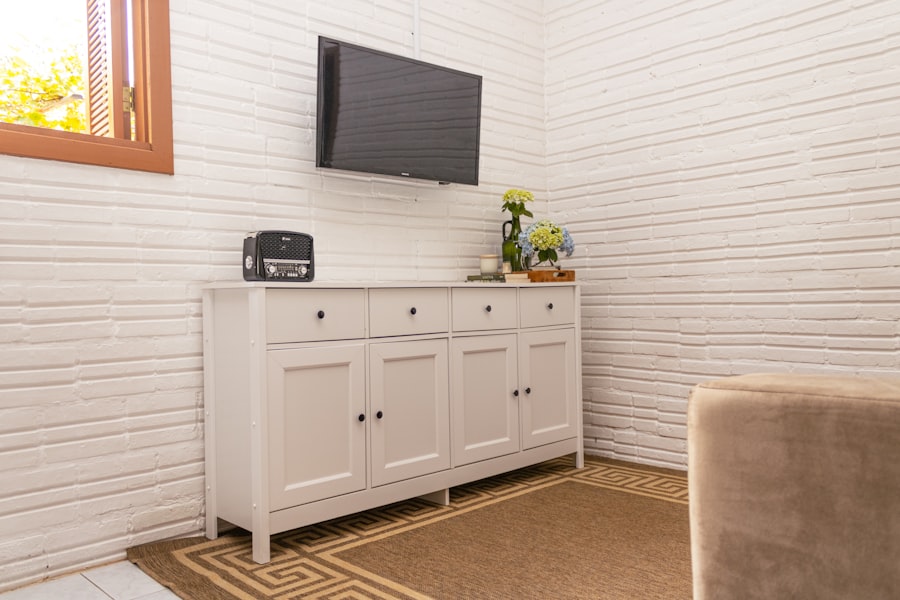Custom entertainment centers offer a multitude of advantages that can significantly enhance the functionality and aesthetic appeal of your living space. One of the primary benefits is the ability to tailor the design to fit your specific needs and preferences. Unlike pre-fabricated options, which often come with limitations in size, style, and configuration, a custom entertainment center can be designed to accommodate your unique collection of electronics, media, and decorative items.
This personalization ensures that every inch of space is utilized effectively, allowing for a seamless integration into your home’s existing decor. Moreover, custom entertainment centers can be designed to reflect your personal style and taste. Whether you prefer a modern, minimalist look or a more traditional, ornate design, the possibilities are virtually endless.
This level of customization not only enhances the visual appeal of your living area but also creates a focal point that can elevate the overall ambiance of the room. Additionally, custom solutions often incorporate features that enhance usability, such as built-in lighting, adjustable shelving, and cable management systems that keep cords organized and out of sight.
Key Takeaways
- Custom entertainment centers enhance room aesthetics and functionality tailored to your space.
- Thoughtful design and material selection ensure durability and style that match your preferences.
- Integrating technology seamlessly improves your entertainment experience and convenience.
- Maximizing storage options helps keep media and accessories organized and accessible.
- Collaborating with professionals ensures a personalized, high-quality entertainment center that meets your needs.
Designing Your Custom Entertainment Center
The design process for a custom entertainment center begins with a thorough assessment of your space and requirements. It is essential to consider the dimensions of the room where the entertainment center will reside, as well as the layout and flow of the space. Taking accurate measurements ensures that the final product fits perfectly without overwhelming the room or obstructing pathways.
Furthermore, understanding how you intend to use the entertainment center—whether primarily for watching movies, gaming, or displaying collectibles—will inform the design choices you make. Incorporating elements such as color schemes, textures, and finishes is also crucial during the design phase. For instance, if your home features a contemporary aesthetic with clean lines and neutral tones, you might opt for a sleek, high-gloss finish in shades of white or gray.
Conversely, if your decor leans towards rustic charm, reclaimed wood with a distressed finish could be more appropriate. Additionally, considering the placement of your television and other media devices is vital; ensuring optimal viewing angles and accessibility will enhance your overall experience.
Choosing the Right Materials for Your Entertainment Center

Selecting the appropriate materials for your custom entertainment center is a critical step that impacts both durability and aesthetics. Wood is a popular choice due to its versatility and timeless appeal. Solid hardwoods like oak, maple, or cherry provide strength and longevity, while also allowing for various finishes that can match any decor style.
Plywood is another excellent option for those seeking a balance between cost-effectiveness and quality; it offers stability and can be finished to resemble solid wood. In addition to wood, other materials such as metal and glass can be incorporated into your design for a modern touch. Metal frames or accents can add an industrial edge, while glass shelves or doors can create an illusion of space and lightness.
When choosing materials, it’s essential to consider not only the visual impact but also how they will hold up over time. For example, if you have children or pets, opting for scratch-resistant finishes or durable laminates may be wise to ensure longevity.
Incorporating Technology into Your Entertainment Center
| Technology | Purpose | Average Cost | Installation Complexity | Benefits |
|---|---|---|---|---|
| Smart TV | Streaming and internet access | 300 – 1500 | Low | Access to apps, streaming services, and voice control |
| Soundbar | Enhanced audio quality | 100 – 800 | Low | Improved sound clarity and surround sound experience |
| Streaming Device (e.g., Roku, Fire Stick) | Streaming content on non-smart TVs | 30 – 100 | Low | Access to multiple streaming platforms |
| Universal Remote | Control multiple devices | 20 – 200 | Medium | Convenience and reduced clutter |
| Gaming Console | Gaming and media streaming | 300 – 500 | Medium | Entertainment and interactive experiences |
| Smart Lighting | Ambient lighting control | 50 – 200 | Medium | Customizable mood lighting and energy efficiency |
| AV Receiver | Audio/video signal management | 200 – 1500 | High | Centralized control of audio and video sources |
In today’s digital age, integrating technology into your custom entertainment center is essential for creating a modern and functional space. Smart home technology can be seamlessly incorporated into your design to enhance convenience and usability. For instance, built-in speakers or sound systems can provide an immersive audio experience without cluttering your space with additional equipment.
Additionally, incorporating smart lighting systems allows you to adjust the ambiance with ease, creating the perfect atmosphere for movie nights or gatherings. Cable management is another critical aspect of incorporating technology into your entertainment center. A well-designed system will hide unsightly cords and cables while providing easy access to power outlets and connections.
This not only improves the visual appeal but also simplifies setup and maintenance. Furthermore, consider including charging stations for devices such as smartphones and tablets within your entertainment center design; this ensures that all your gadgets are easily accessible and charged when needed.
Maximizing Storage and Organization
A well-designed custom entertainment center should prioritize storage and organization to keep your space tidy and functional. With the proliferation of media devices, games, DVDs, and accessories, having designated storage solutions is essential. Custom shelving can be tailored to fit specific items, ensuring that everything has its place while remaining easily accessible.
For example, adjustable shelves allow you to modify the height based on the size of your media collection or decorative items. Incorporating drawers or cabinets into your design can further enhance organization by providing concealed storage for items that may otherwise create clutter. These hidden compartments are perfect for storing remote controls, gaming accessories, or even board games that you want to keep out of sight but still within reach.
Additionally, consider using decorative baskets or bins within open shelving to create a visually appealing yet organized display that complements your overall design.
Customizing Your Entertainment Center for Your Needs

Every household has unique needs when it comes to entertainment centers, making customization crucial for achieving optimal functionality. For instance, if you are an avid gamer, you may require additional shelving or compartments specifically designed for gaming consoles and accessories. This could include dedicated spaces for controllers, headsets, and game discs to ensure everything is organized and easily accessible during play.
Moreover, if you frequently host gatherings or movie nights with family and friends, consider incorporating features such as built-in seating or a bar area within your entertainment center design. This not only enhances the social aspect of your space but also creates a multifunctional area that caters to various activities. By taking the time to assess your lifestyle and preferences, you can create an entertainment center that truly meets your needs.
Working with a Professional to Create Your Custom Entertainment Center
While some homeowners may feel confident in their ability to design their own custom entertainment centers, collaborating with a professional can elevate the final product significantly. Experienced designers or carpenters bring valuable insights into space planning, material selection, and construction techniques that can save time and prevent costly mistakes. They can also help you navigate any challenges related to building codes or structural considerations that may arise during the project.
When working with a professional, it’s essential to communicate your vision clearly while remaining open to their suggestions based on their expertise. A skilled designer will take into account not only your aesthetic preferences but also practical considerations such as lighting, acoustics, and ergonomics. This collaborative approach ensures that the final product is not only visually stunning but also functional and tailored to your specific needs.
Maintaining and Caring for Your Custom Entertainment Center
Once you have invested in a custom entertainment center, proper maintenance is key to preserving its beauty and functionality over time. Regular cleaning is essential; dusting surfaces with a soft cloth will prevent buildup that can dull finishes or scratch surfaces. For wooden components, using appropriate cleaning products designed specifically for wood can help maintain its luster without causing damage.
Additionally, it’s important to periodically check for any signs of wear or damage. Inspecting hinges on doors or drawers ensures they function smoothly while addressing any issues promptly can prevent more significant problems down the line. If your entertainment center incorporates electronic components or technology features, ensure that these are regularly updated and maintained as well; this will help keep everything running smoothly while enhancing your overall experience in using the space.
By understanding these various aspects of custom entertainment centers—from their benefits to maintenance—you can create a personalized solution that enhances both functionality and aesthetics in your home.



